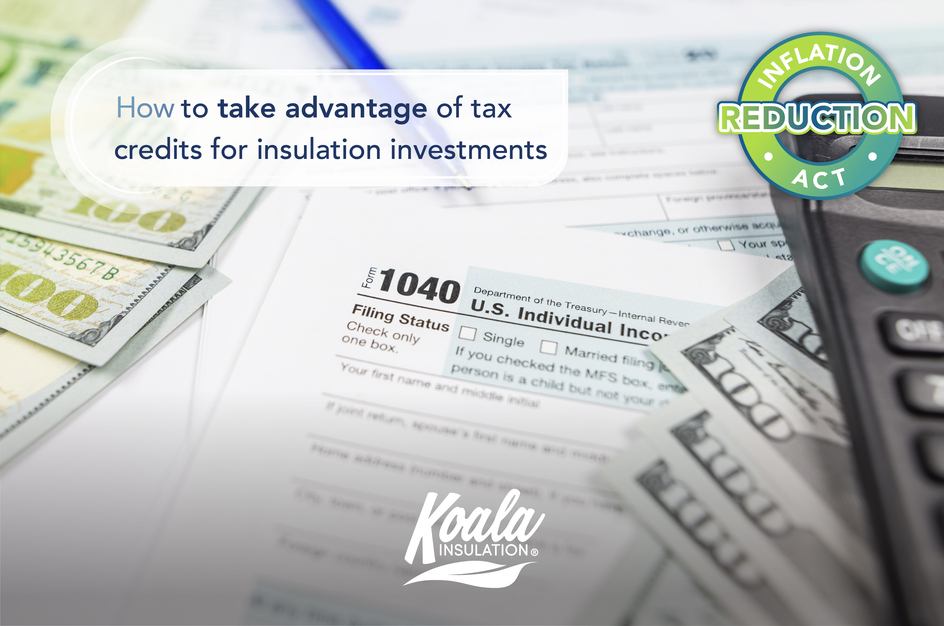
How to take advantage of tax credits for insulation investments
As the cost of living continues to rise, homeowners are searching for ways to save money on their energy bills. One solution is to invest in insulation. Insulation can reduce the transfer of heat through walls, floors, and ceilings, which can help to keep your home warm in the winter and cool in the summer. Additionally, homeowners can take advantage of tax credits for insulation investments, which can reduce the overall cost of insulation. In this blog post, we will explore how to take advantage of tax credits for insulation investments, including the Inflation Reduction Act, and tax credits for Energy Star rated homes.
The Inflation Reduction Act of 2022 allows for a tax credit for the installation of insulation. This tax credit is available to homeowners who install insulation in their primary residence. The tax credit is equal to up to 30% of the cost of insulation, a maximum of $1200. This tax credit applies to insulation installed from now up until 2032.
In addition to the Inflation Reduction Act, homeowners can also take advantage of tax credits for Energy Star rated homes. Energy Star is a program that certifies homes and products that meet certain energy efficiency standards. As part of the recently passed Inflation Reduction Act, the Section 45L Tax Credit for Energy Efficient New Homes has been updated and extended. For homes and units acquired on or after January 1, 2023, the base level tax credit will be specifically tied to ENERGY STAR certification for single-family, manufactured, and multi-family homes. This tax credit has been extended through 2032. Details are below:
Single-Family New Homes - $2,500 available for ENERGY STAR certified homes.
- January 1, 2023 – December 31, 2024: ENERGY STAR Single-Family New Home National Version 3.1.*
- January 1, 2025 – December 31, 2032: ENERGY STAR Single-Family New Homes National Version 3.2.*
* EPA is awaiting guidance from the IRS on the applicability of state/regional versions of the ENERGY STAR program requirements.
- Manufactured Homes - $2,500 available for ENERGY STAR certified manufactured homes meeting the most recent ENERGY STAR Manufactured New Homes program requirements (currently Version 2, with Version 3 scheduled to be implemented in May 2023).
- Multifamily - $500 available for ENERGY STAR certified multifamily units meeting the ENERGY STAR Multifamily New Construction National program requirements (or the regional program requirements) applicable to the dwelling unit, as specified in Section 13304. A larger tax credit is available for multifamily projects that meet prevailing wage requirements.
A larger tax credit is available for homes that are certified to DOE’s Zero Energy Ready (ZERH) Program, which requires ENERGY STAR certification as a prerequisite.
All official information related to the tax credit will be determined and published by the IRS. The ENERGY STAR team is committed to keeping our partners informed as the IRS works to develop updated documents and guidance.
Source: https://www.energystar.gov/about/federal_tax_credits/federal_tax_credit_archives/tax_credits_home_builders
Steps to taking advantage of tax credits
Investing in insulation and other energy-efficient home improvements can provide many benefits beyond the tax savings. For example, an energy-efficient home can reduce energy bills, improve indoor air quality, and increase the resale value of the home. To take advantage of these tax credits, homeowners should take the following steps:
- Determine which tax credits are available. Homeowners can consult with a tax professional or visit the IRS website to determine which tax credits are available to them.
- Ensure that the insulation and other energy-efficient improvements meet the qualifications for the tax credit. Homeowners should work with a licensed insulation contractor or other professional to ensure that the improvements they make meet the necessary qualifications.
- Keep accurate records of the insulation installation and other energy-efficient improvements. Homeowners should keep records of the contractor's name, address, and license number, as well as the date of installation, the type of insulation installed, and the cost of installation.
In conclusion, investing in insulation and other energy-efficient improvements can provide many benefits, including tax savings, lower energy bills, and increased home value. By taking advantage of tax credits for insulation investments, homeowners can reduce the cost of insulation while also improving the comfort of their homes.
Contact us today at Koala Insulation of North Broward and Boca to schedule a free in-home consultation and guide you towards a more comfortable and energy-efficient home taking advantage of the tax credits you deserve.
Ready to book your free insulation evaluation?
We have 3 convienant ways for you to get in touch
We Provide Insulation Services to the Following North Broward & Boca Areas
BOCA RATON, DELRAY BEACH, POMPANO BEACH, CORAL SPRINGS, TAMARAC, DEERFIELD BEACH
Counties Served
PALM BEACH, BROWARD
Zip Code
33431, 33432, 33433, 33444, 33445, 33483, 33486, 33487, 33076, 33428, 33434, 33446, 33484, 33496, 33498, 33063, 33065, 33071, 33321, 33064, 33067, 33073, 33441, 33442
